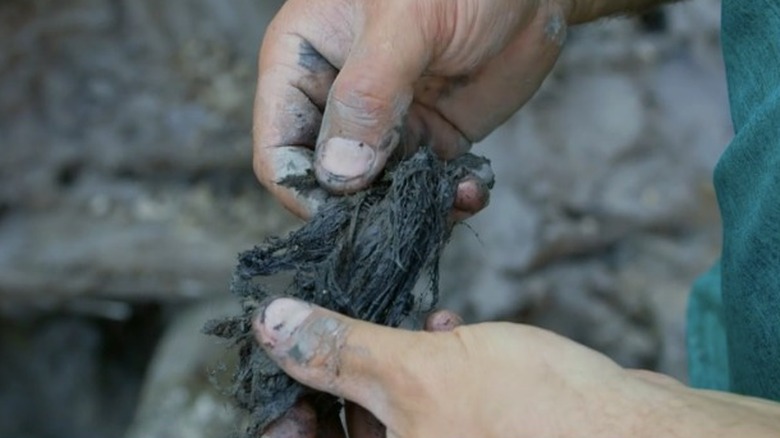Host Marty Lagina Explains Curse Of Oak Island's Bizarre Coconut Treasure
Fans of History's long-running reality treasure hunt "The Curse of Oak Island" are no strangers to disappointment. For nearly a decade, viewers have followed brothers Rick and Marty Lagina and their ragtag team of experts and volunteers as they partake in a tireless quest for a supposedly cursed, supposedly real buried treasure on a small island off the coast of Nova Scotia. Although to date, no actual treasure has been found, that hasn't stopped fans from getting excited each time the brothers excavate another compelling piece of detritus from their various dig sites.
This excitement reached ever more baffling levels in Season 7 when the team discovered a mysterious clump of hardened material on the island's Smith's Cove. In an interview with Stephen Colbert for The Late Show, Marty Lagina explained why this seemingly mundane discovery meant so much to the series' quest. Holding the find — which was packed neatly and professionally in a large Ziploc bag — up to the camera, Colbert noted that it looked "a little like dog poop."
Though Marty couldn't disagree with the assessment, he did manage to defend its significance. "That," Marty said, "is actually coconut fiber."
Why is coconut fiber an important find for the Laginas?
"What is coconut fiber doing in Nova Scotia, my friend?" Stephen Colbert asked during his interview with the Lagina brothers, before adding, "Bingo — treasure."
Though it may not be treasure in the most traditional sense, Marty explained that its anachronistic placement is exactly what makes it special. According to Marty, sailors used to use coconut fiber to keep things from "shifting around" in ships (similar to an early form of those dreaded packing peanuts). The team found a pair of old scissors buried underneath a layer of coconut fiber, which led them to believe it could have been an integral part of the treasure's history. The discovery of a tropical fruit husk buried deep in the ground in the far northeast corner of North America certainly seems like a compelling mystery, but just how mysterious is it?
At the risk of disappointing "The Curse of Oak Island" addicts everywhere, it turns out that the team's coconut discovery isn't as exciting as viewers were led to believe. According to ArcheoThoughts' investigation of the existence of coconuts in the area around the time the treasure is rumored to have been concealed, a number of archeological records reveal they were a far more common find than the series suggests.
How excited should viewers be about the coconut treasure?
Citing a litany of records compiled by Davis Archaeological Consultants Limited, Elizabeth Driver (in "The Ward Uncovered: The Archaeology of Everyday Life"), The New Netherland Institute, and Geoarcheology Research Associates, ArcheoThoughts explains, "[I]t is clear that coconuts were circulating quite widely in all of Northeastern North America by the middle of the 19th century, and that they were available and used inland as early as the 17th century." Most likely, the author concludes, the fiber was used for rope making, though they couldn't dismiss entirely the idea that it might have been used by the Templar Knights to pack treasure on a ship and then brought to Oak Island as part of a secret mission.
Of course, whether or not the coconut discovery actually points to its utilization in the burying of treasure isn't really the point. At least, with regard to the series' ratings (and what makes it so compelling to viewers), the oddball find serves a far greater purpose. There's a reason that, for nine whole seasons, viewers have continued to tune in to "The Curse of Oak Island" each week, and it has nothing to do with treasure. The truth is we just can't help but root for the Laginas. It's in our nature to hope that even the most obvious windmill — be it a bottomless money pit or an ordinary lump of coconut fiber — is, despite all evidence to the contrary, actually a giant.


